flash freezing demonstration dango
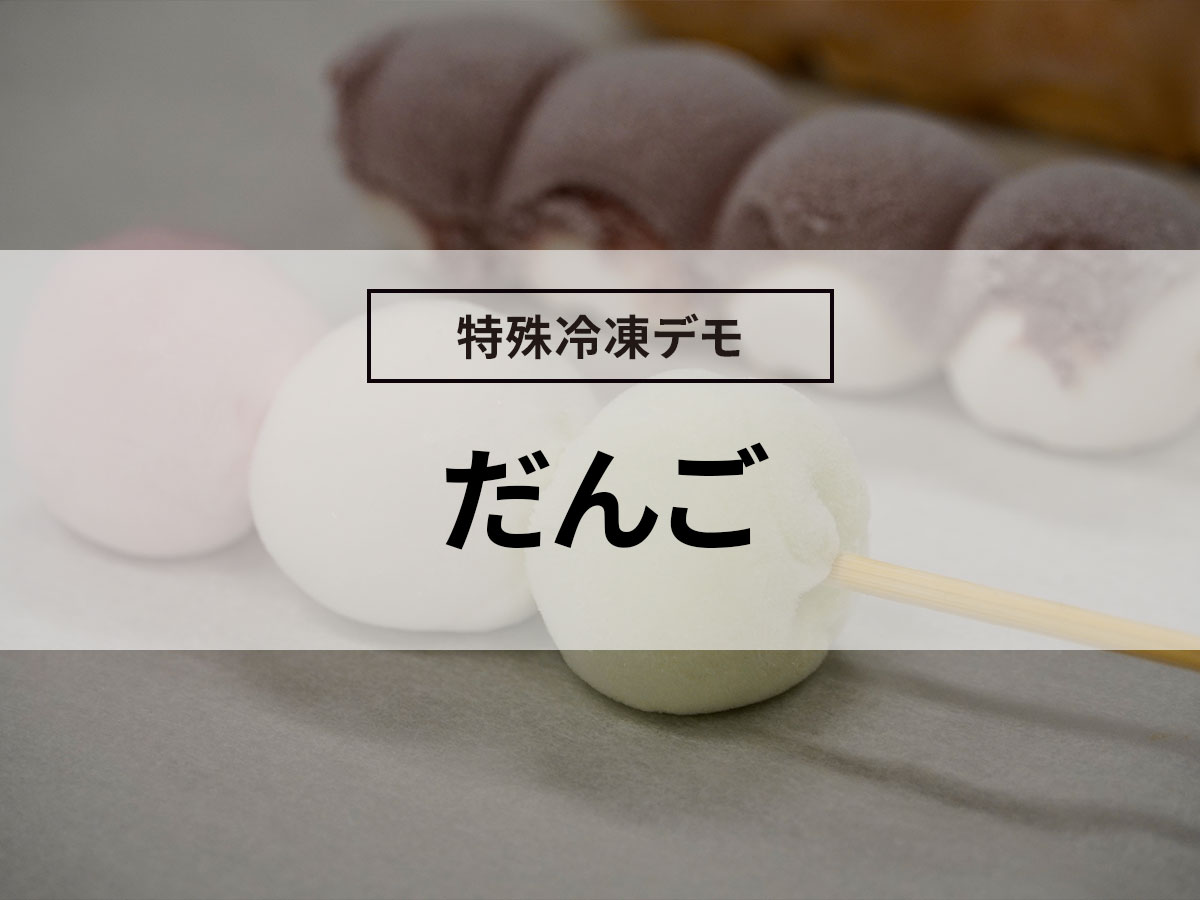
This time, we conducted an experiment from freezing to thawing for a customer who sells dangos who wanted to deliver dangos to the general public through e-commerce sales.
We will tell you about the key points and thawing methods for freezing high-quality dango in the Artlock Freezer.
First, the purpose of this experiment.
➀ Comparison of Artlock freezer settings during freezing and quality of different types of dango (first half)
② Comparison of quality based on different dango thawing methods (second half)
We will report the results of a sensory evaluation of these differences.
➀ Comparison of Artlock freezer settings during freezing and quality of different types of dango
This time, we set two settings for freezing using the Artlock Freezer, setting A and setting B, and conducted a sensory evaluation to see if there was actually a difference in quality.
A total of four types of dango were used: mitarashi dango, koshi dango, mugwort dango, and three-colored dango.
frozen
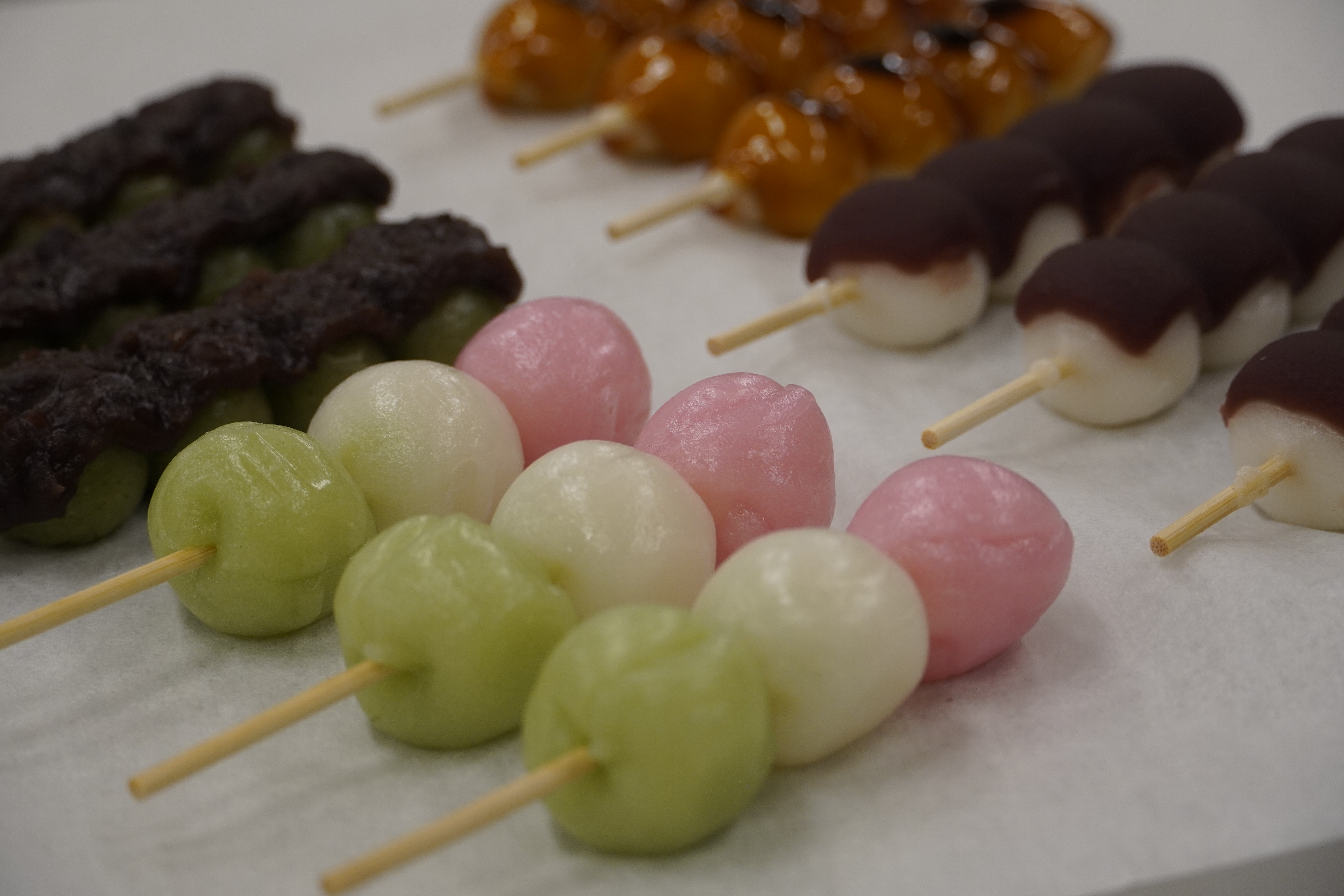
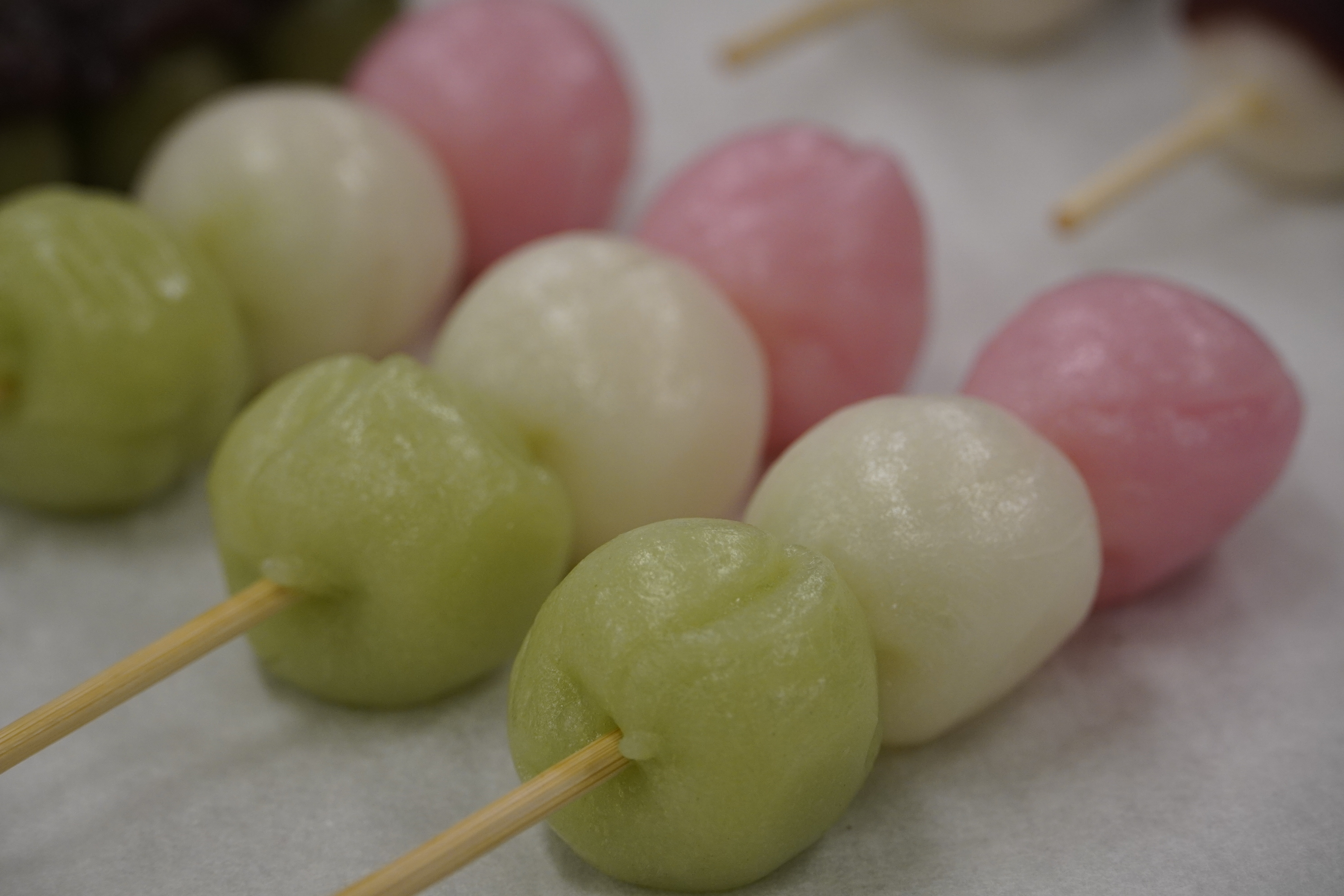
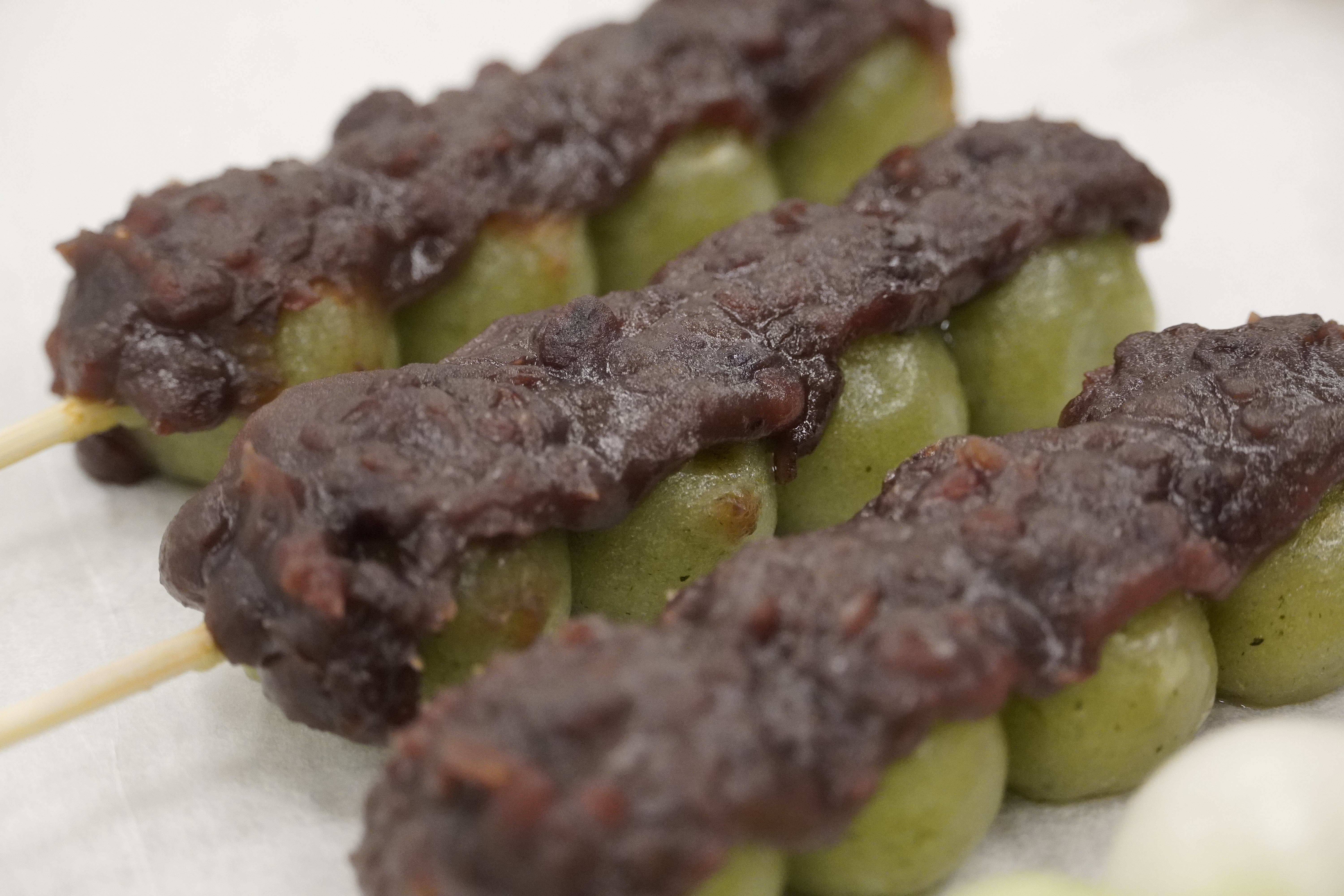
We will freeze these in two batches by changing the settings of the Artlock freezer.
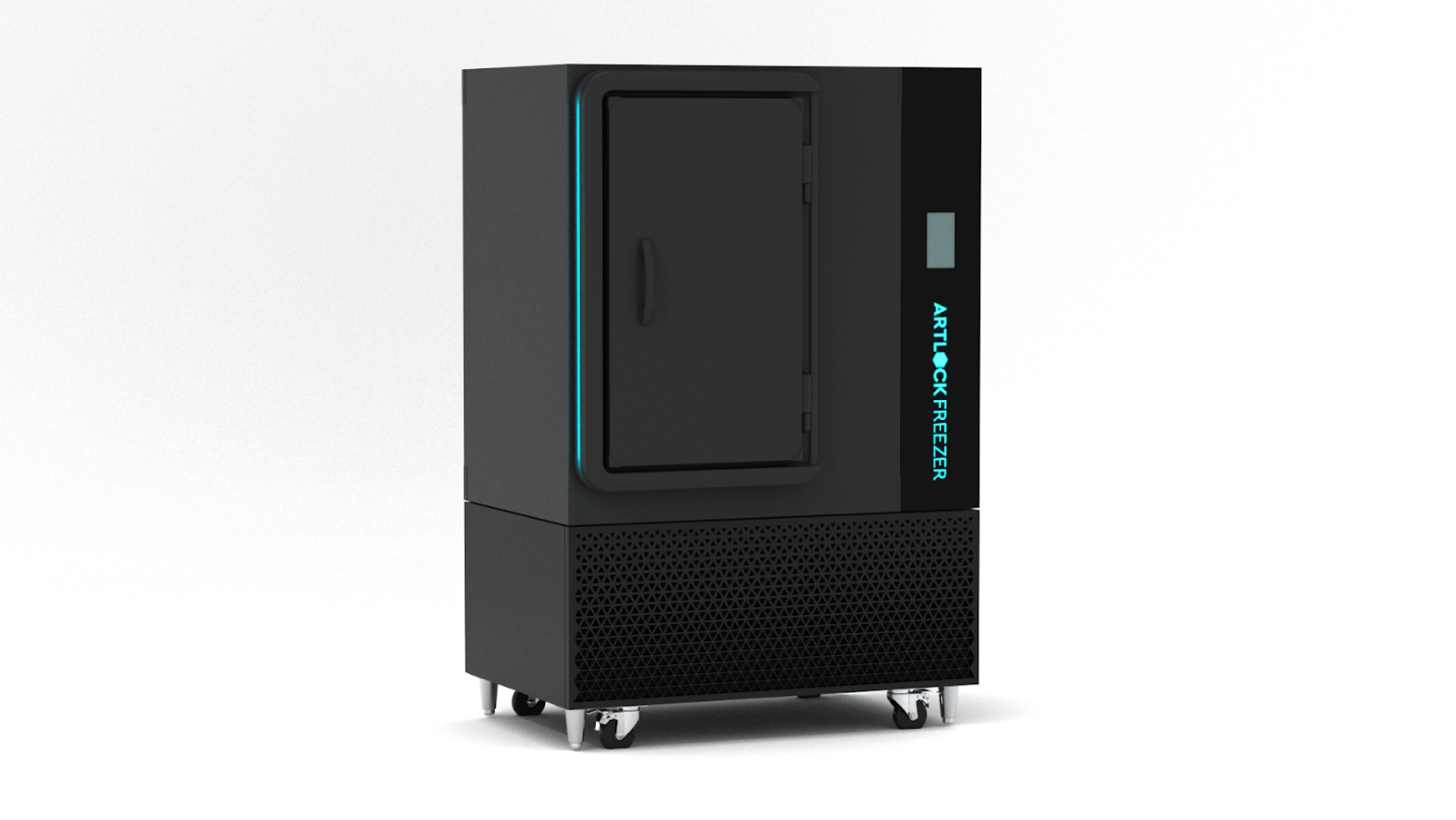
Especially when rapid freezing ingredients like red bean paste on top of dumplings or mitarashi sauce, as in this case, using an air freezing type like Artlock Freezer will help. It can be frozen while maintaining its shape and appearance.
The reason for this is that the finished food can be frozen without packaging, but with liquid freezing, it is difficult to maintain the shape and appearance of the food because it needs to be wrapped and vacuumed before freezing.
This time, we conducted an experiment using an Art-Lock Freezer because in addition to maintaining the quality of freshly made products, using an Art-Lock Freezer also adds visual value.
One skewer could reach a core temperature of -18℃ within about 30 minutes.
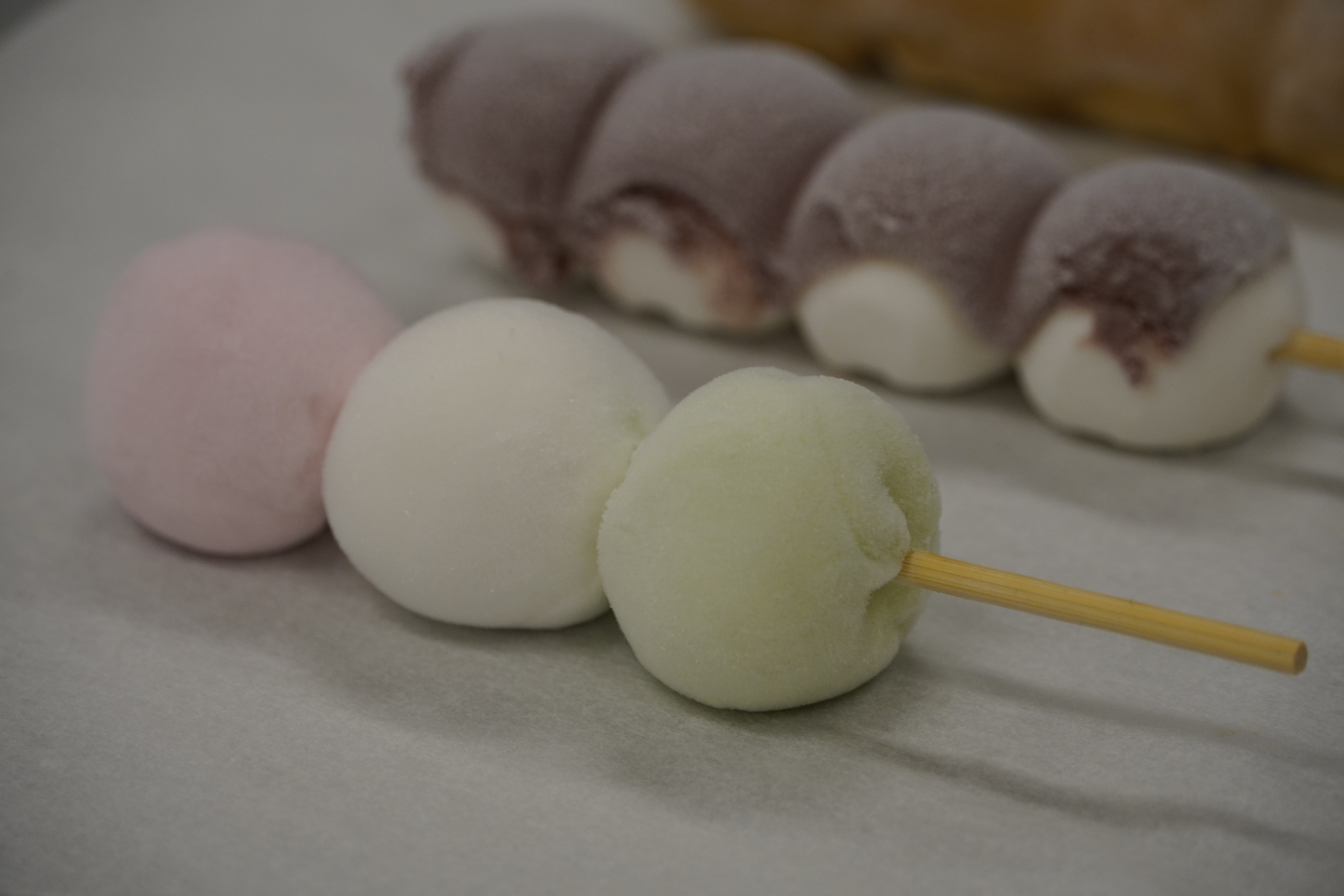
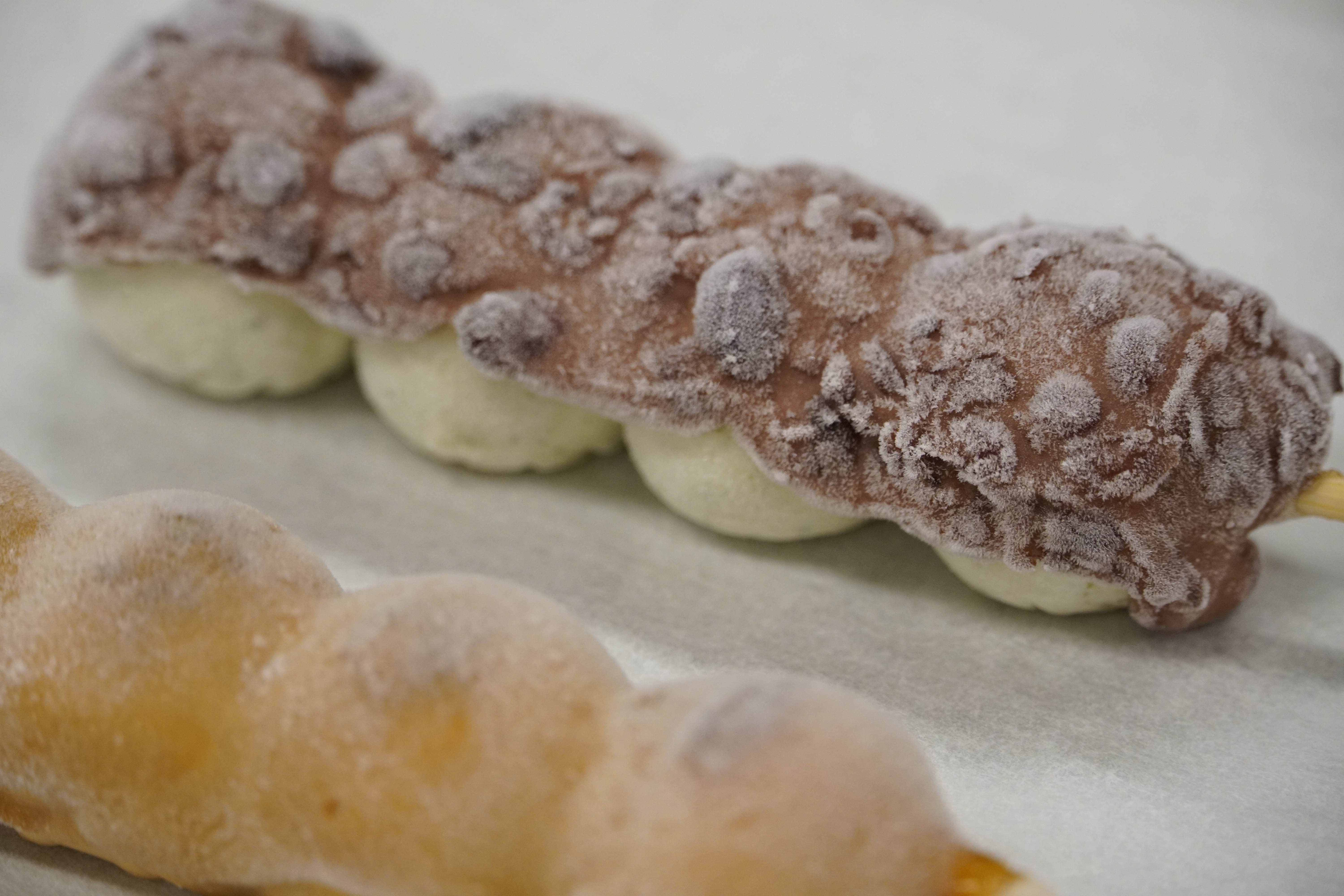
The frozen dango was vacuumed and stored for 2 weeks.
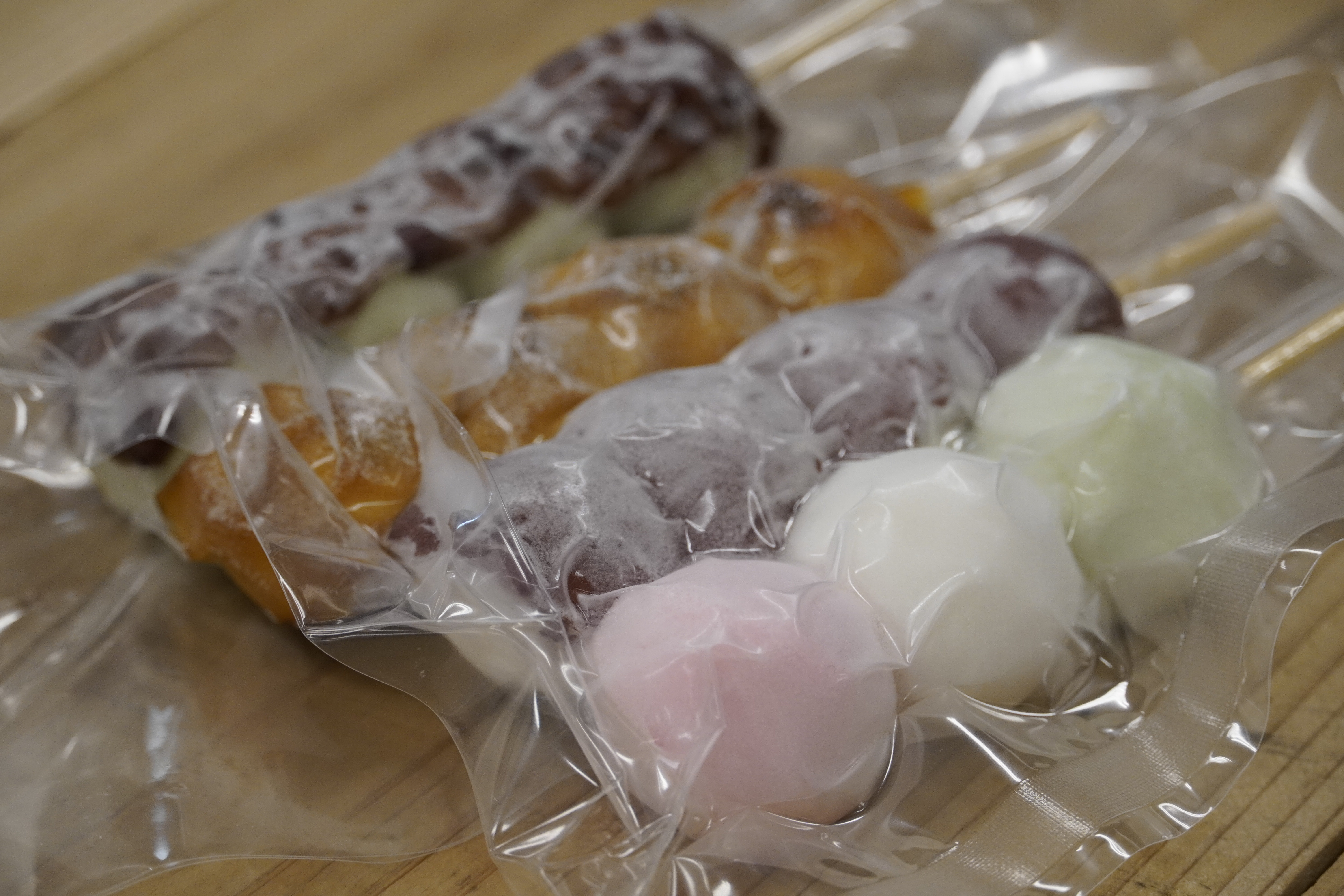
Thawing/sensory evaluation
After storing the frozen dango for two weeks, they were thawed and subjected to sensory evaluation of appearance and taste (texture).

In the sensory evaluation of appearance, there was almost no difference between the setting methods, as shown in the photo.
On the other hand, the following differences were found in the sensory evaluation of taste (texture).
- Sensory evaluation of the three-color dango revealed a large difference in dryness (hardness) between setting A and setting B.
- Mitarashi dango, koshiandango, and mugwort dango did not have as big of a difference as the three-color dango.

② Comparison of quality by different dango thawing methods
From here, we will compare and verify the quality of different defrosting methods.
This time, we verified three decompression methods under the following conditions.
Storage period: 2 weeks
Defrosting method: Microwave thawing 200W 2 and a half to 3 minutes, hot water bath thawing 3 and a half to 4 minutes, room temperature thawing 2 hours
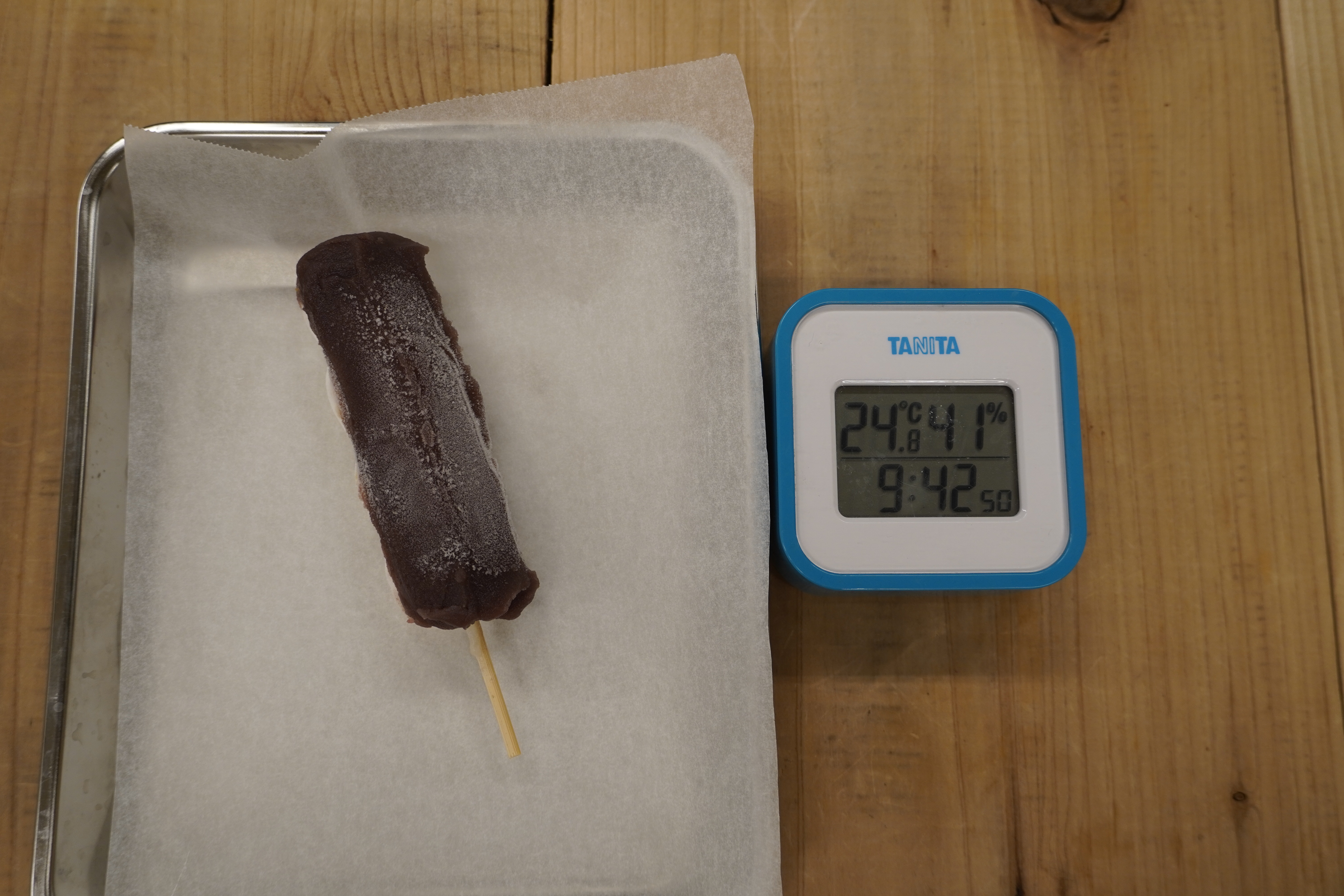

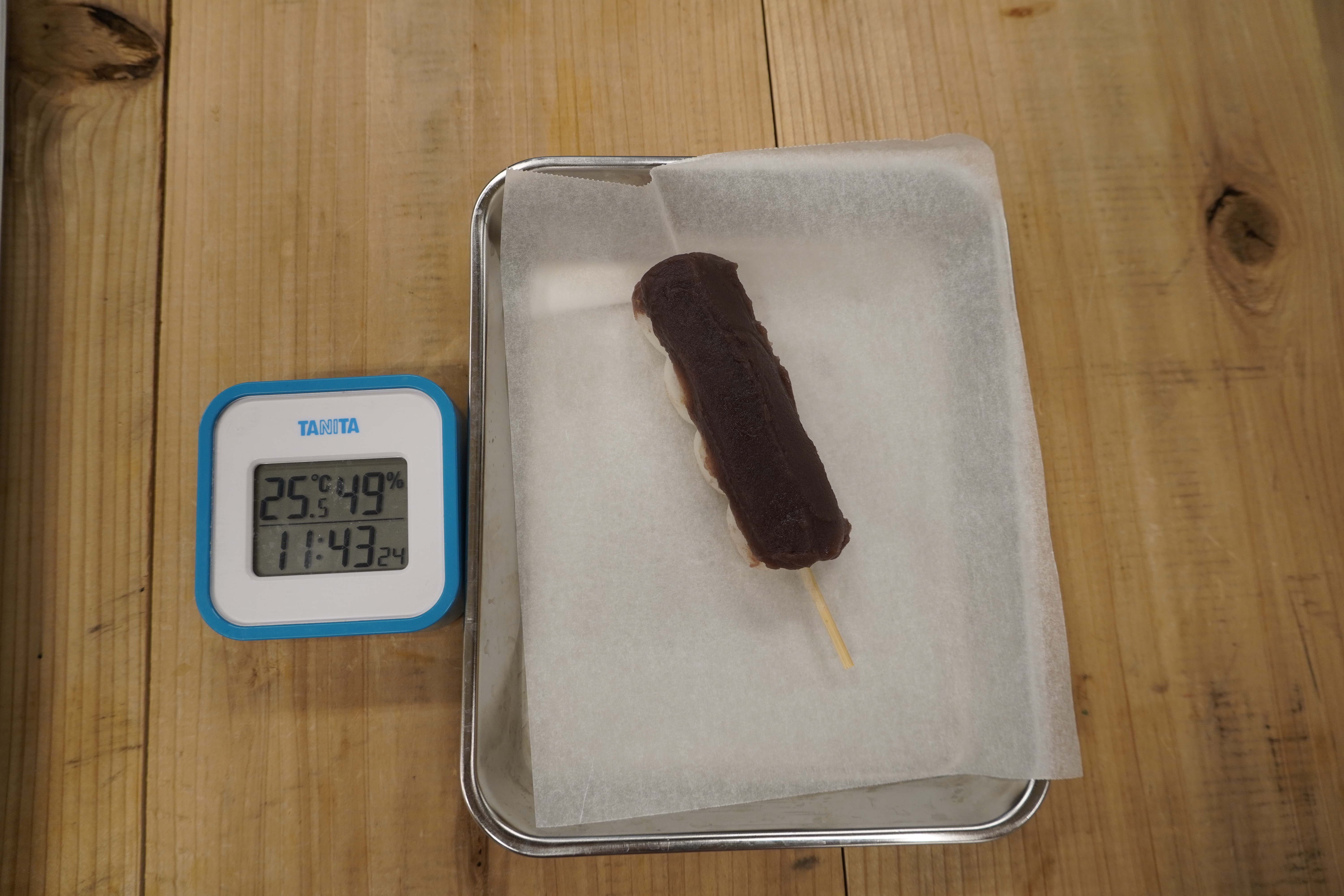
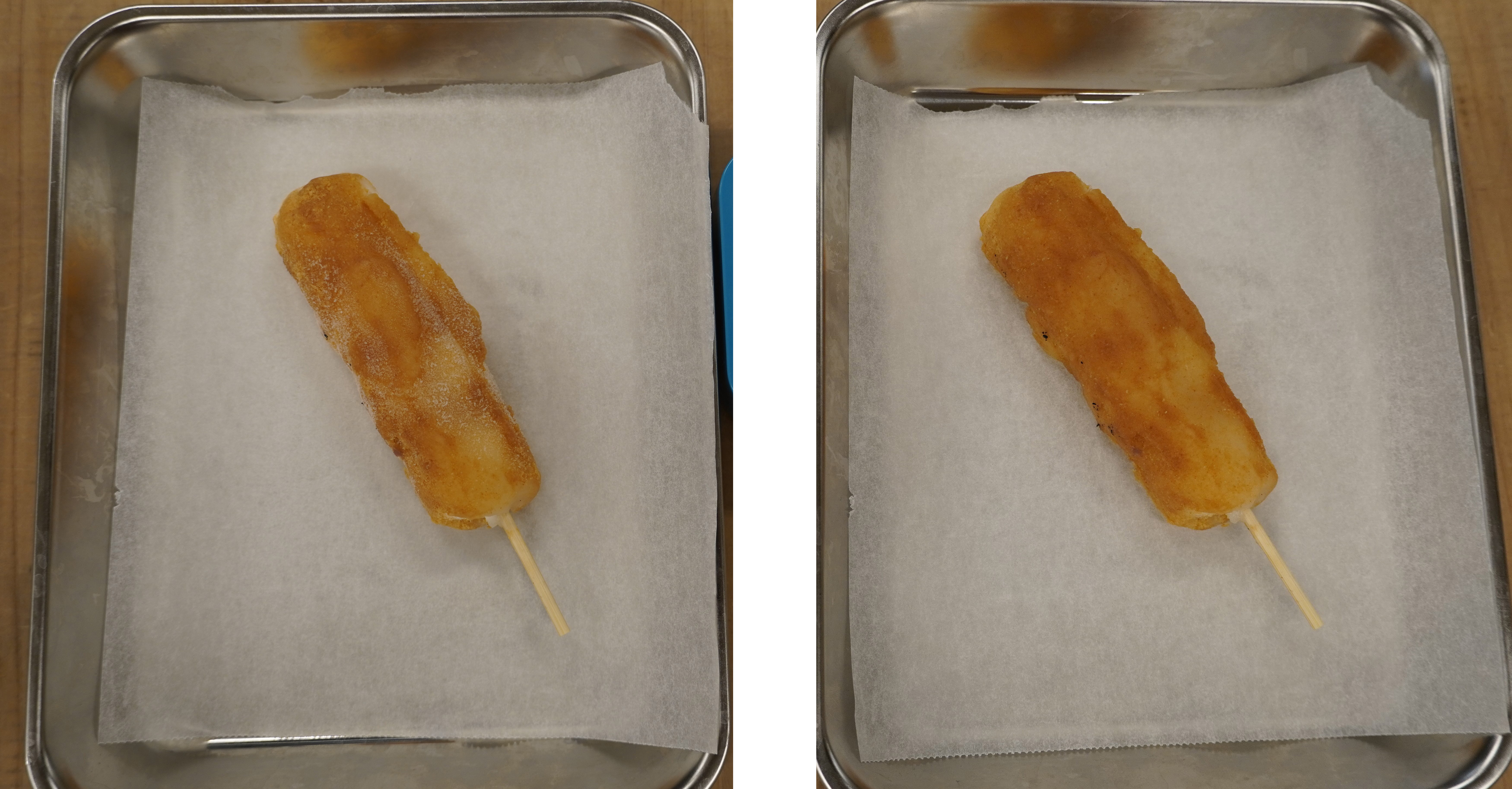

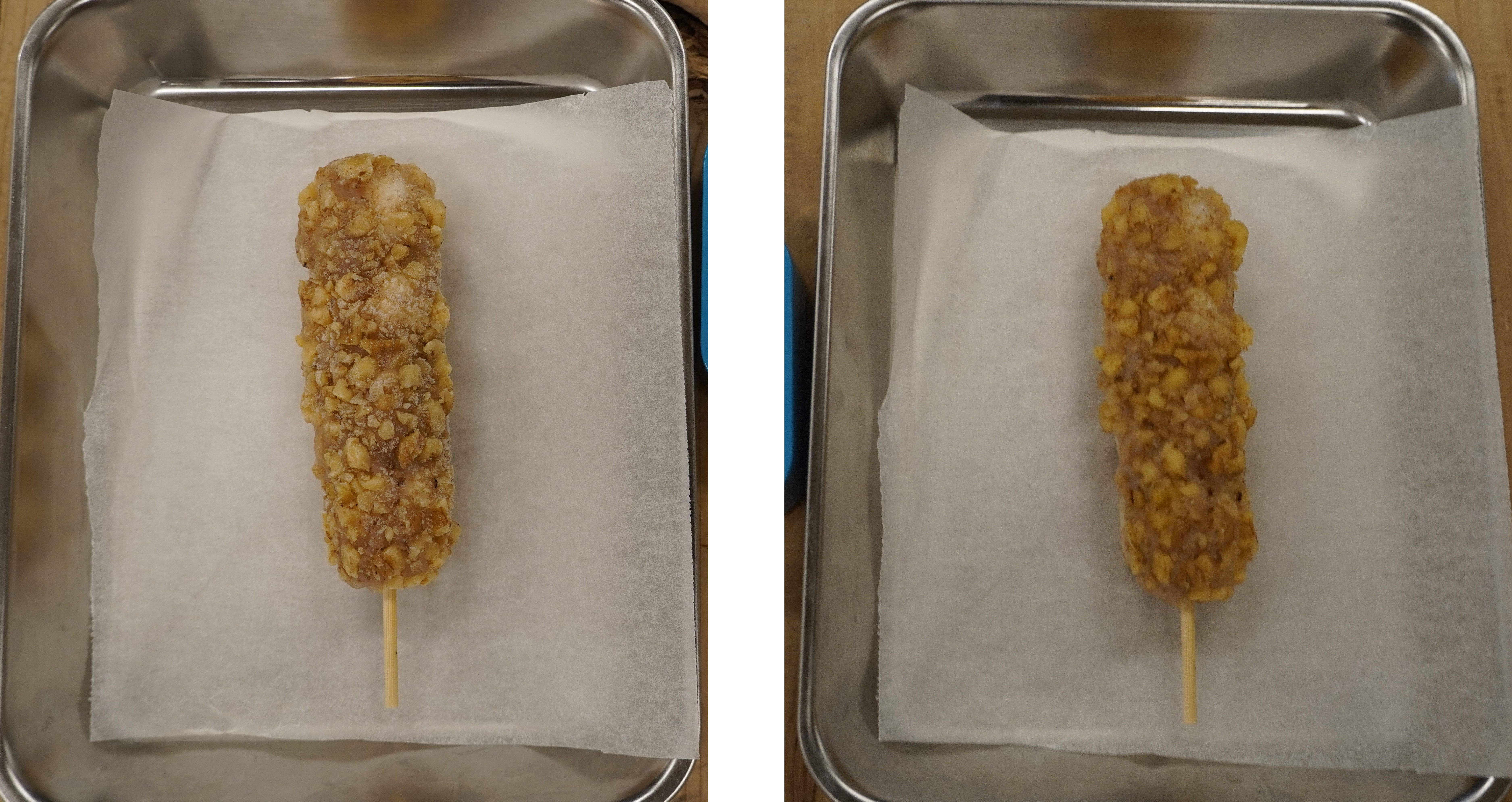
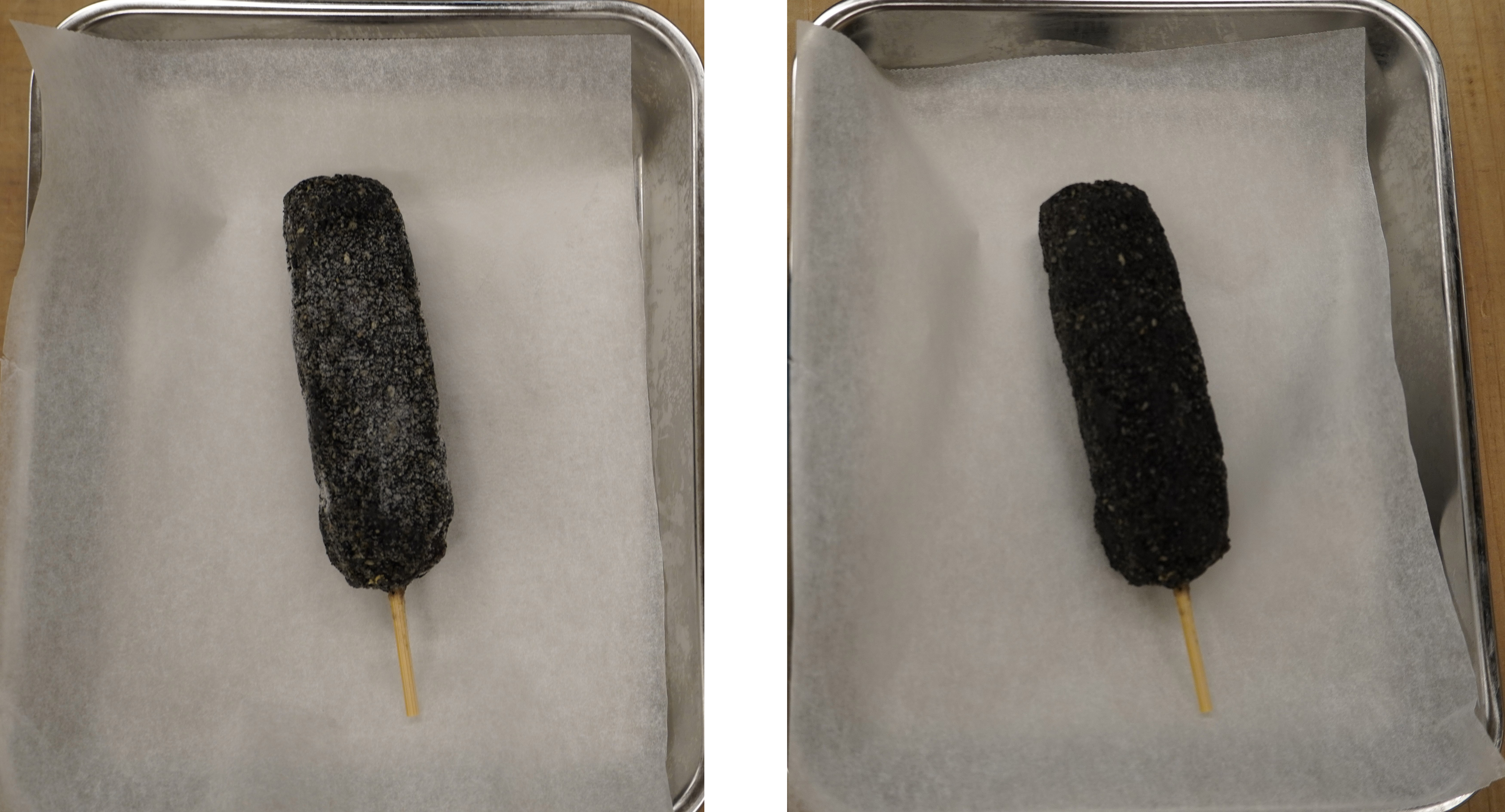
Sensory evaluation of differences depending on thawing method
| How to unzip | comment | Thawing time | How to improve | Recommendation |
|---|---|---|---|---|
| microwave oven | The surface is a little dry, but the reproducibility is good. | Low wattage 200W approximately 2 and a half to 3 minutes | If you are concerned about dryness, add water with a brush or sprayer, wrap and microwave. | ★★ |
| hot water bath | It was chewy and had a scent and moisture. It also has the highest reproducibility. | 3 and a half to 4 minutes | Bean paste etc. are served separately. | ★★★ |
| At normal temperature | Yield remains unchanged even after thawing. ●(About soybean, walnut, and sesame) The aroma was strong, but I was concerned about the hardness of the mochi. ●(About koshian and zunda) Because the bean paste is thick, the overlapping parts are less likely to feel dry, and the bottom part felt dry. | Approximately 2 hours at room temperature of approximately 24℃ | Faster thawing time, higher temperature, and type selection | ★ |
In this verification, we researched the thawing method that would best improve quality, and thawing in a hot water bath gave the best results, but in fact, no matter which thawing method you used, you could eat it just as good before or after freezing. .
The Daybreak Lab team conducts research every day.
If you have any questions about freezing food, please feel free to contact us.
In fact, Japanese confectionery shops that have introduced Artlock freezers are freezing a variety of other Japanese confections in addition to dango.
We also plan to verify and report on "Ohagi" in the future.
Please look forward to the results!








![[Storage period increased by 30 times! ] Achieving a stable supply of raw whitebait!](https://shunkashutou.com/wp-content/uploads/2016/11/579c55e6d32e1385c250e8e7c3ed59a71.jpg)
![[Sales increased 100 times! ] rapid freezing the signature menu “Ni-katsu sandwich”!](https://shunkashutou.com/wp-content/uploads/2016/11/IMG_02391.jpg)
![[Horse sashimi] We have significantly reduced waste loss with rapid freezer!](https://shunkashutou.com/wp-content/uploads/2016/11/5fda59d0cbcdabde18e58c3c58c09ed0.jpg)




![[Storage period increased from 3 days to half a year! ] Restaurants are expanding their business using wholesale and mail order!](https://shunkashutou.com/wp-content/uploads/2018/04/66c19942ab4ba346fdb64ccc04cde373.png)
![[Reduce loss from 200 kg of oysters to zero] Improve loss and expand business with rapid freezer](https://shunkashutou.com/wp-content/uploads/2018/06/19785ca583a8d3c4041c7c192d041b0d.jpg)














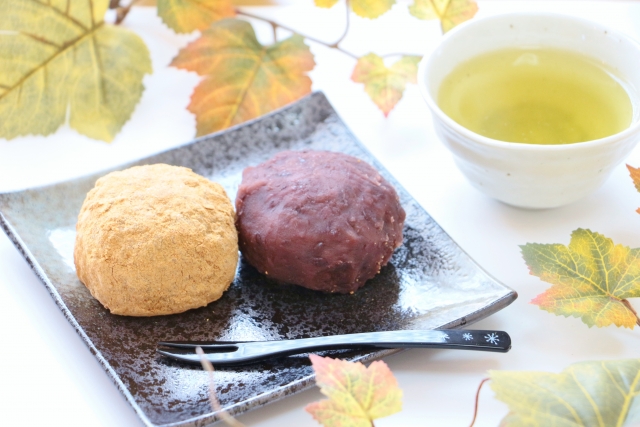
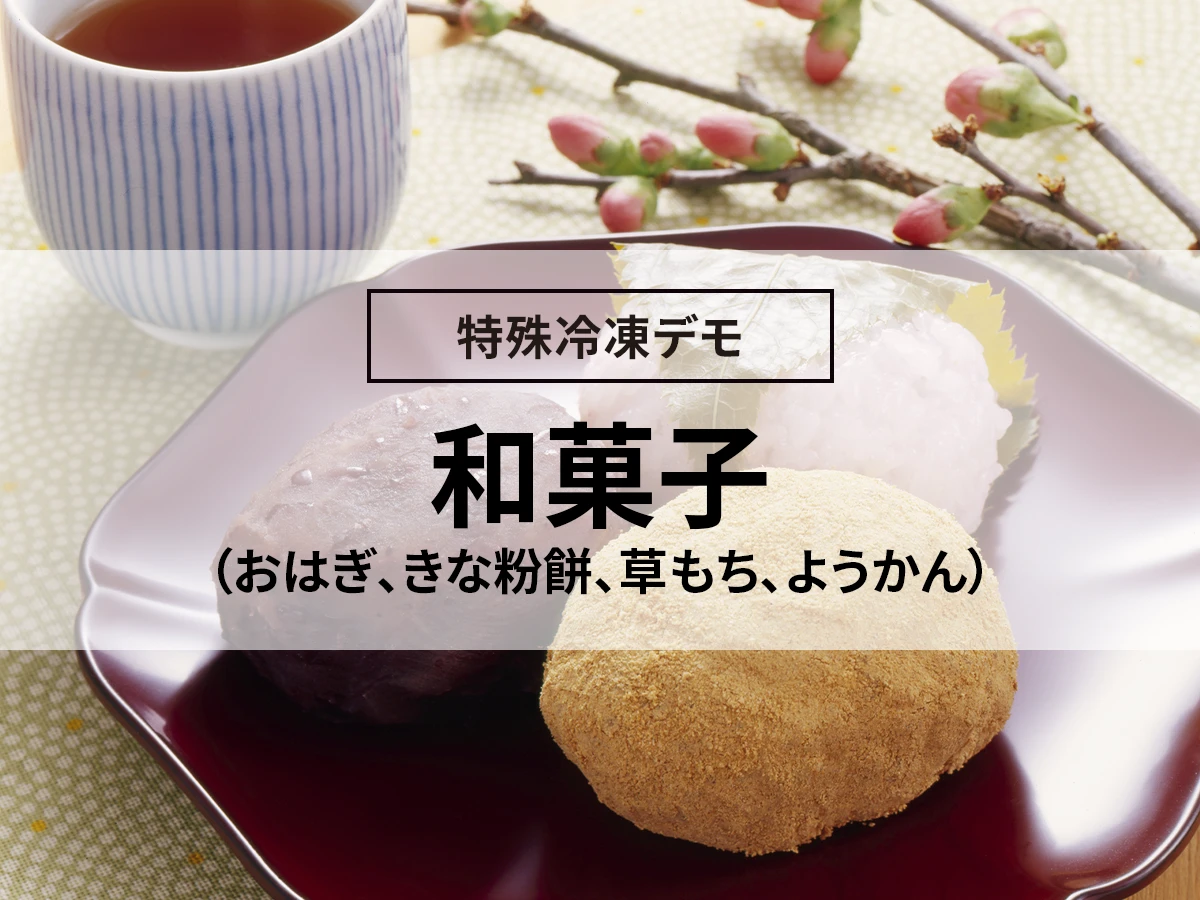
![[Thorough Guide to Preserving Sweets] Introducing the freezing method, storage period, and thawing method in detail!](https://shunkashutou.com/wp-content/uploads/2023/10/bffcbc0b6e79bb1af6e05b930e11e949.jpg)
![[Osechi remake dishes too! ] Introducing the method and recipe for freezing black beans](https://shunkashutou.com/wp-content/uploads/2023/09/9bcd5b0667eef32b7c7daf786e01172f.jpg)

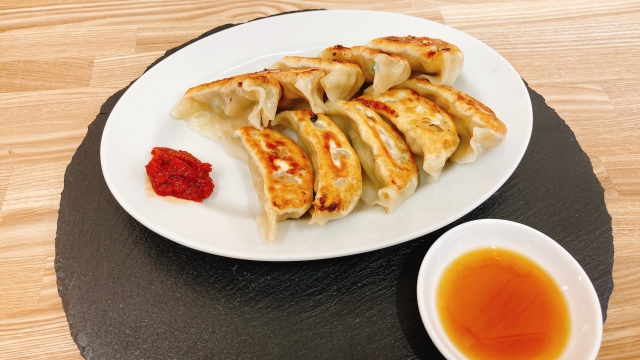
![[Explanation with photos] How to freeze salmon fillets, storage period, and 5 recipes](https://shunkashutou.com/wp-content/uploads/2023/10/fb96564ba06a8cc88a72f0c971ad54e5.jpg)
![How to freeze rice cake, expiry date, and 5 recipes! [Explanation with photos! ]](https://shunkashutou.com/wp-content/uploads/2023/10/bd019f04ad570f697ffefe9ffd2e1e71.jpg)
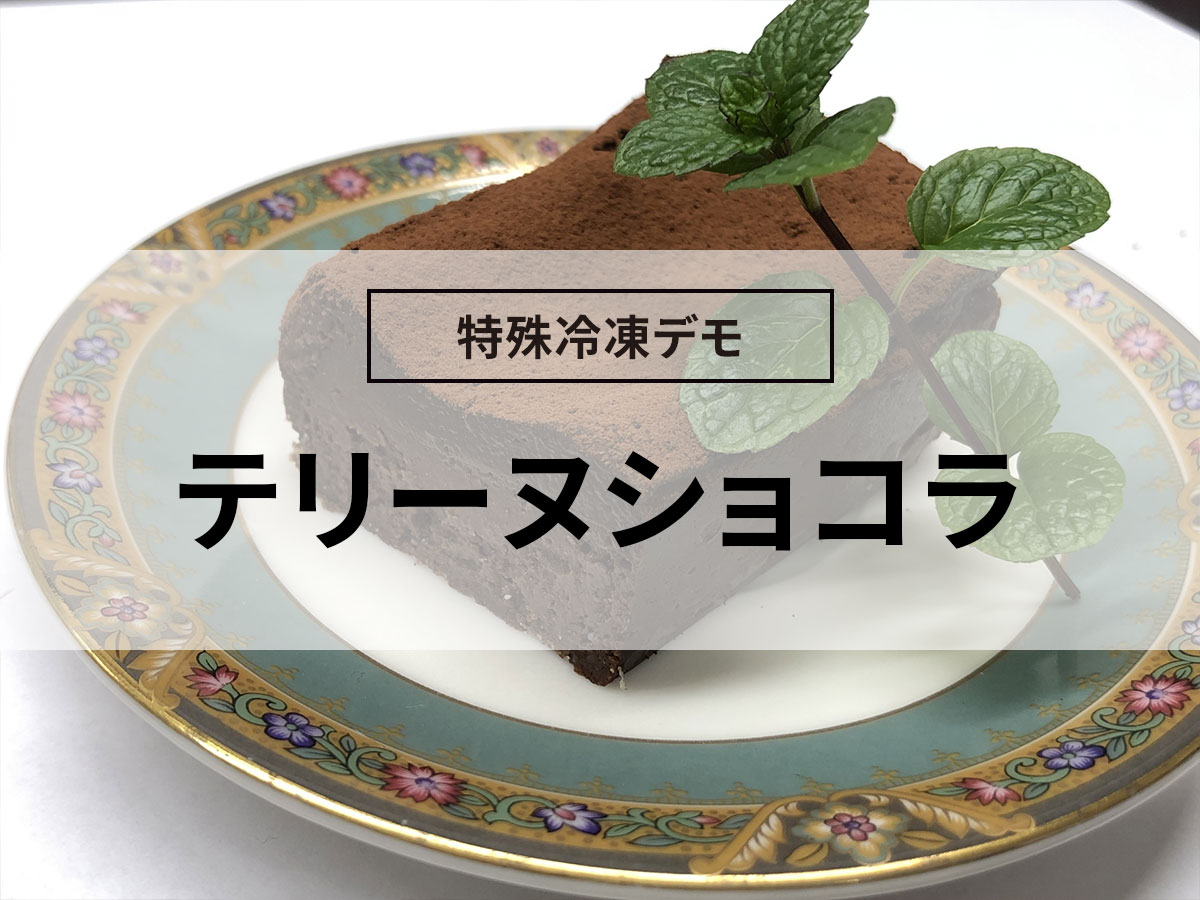
![[Delicious, Convenient, Cheap] Recommended commercial frozen foods for restaurants to purchase](https://shunkashutou.com/wp-content/uploads/2023/07/business-frozen-food-1024x682-1.jpg)
![[Explanation with photos! ] How to freeze hijiki and its storage period, 5 recipes!](https://shunkashutou.com/wp-content/uploads/2023/09/ff6bdc527dd066b7d725a48161d7925d.jpg)
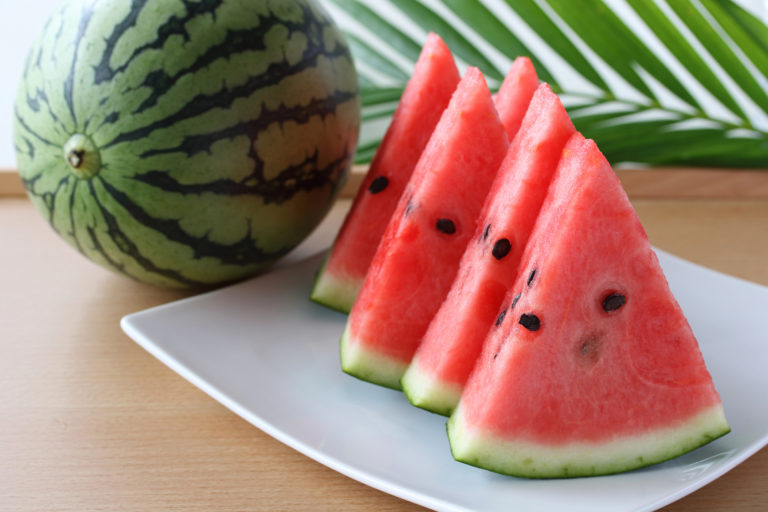
![[Fruit becomes dessert! ] How to freeze kiwi and sweets recipes](https://shunkashutou.com/wp-content/uploads/2023/09/ecc0fc2bc14391ea13ce2e7a43d1416e.jpg)
![[Explanation with photos! ] How to freeze beef, storage period, and 5 recipes!](https://shunkashutou.com/wp-content/uploads/2023/07/8717f2a867f52157bab47841b0f29019.jpg)
![[Includes grilling instructions] How to freeze hamburger steak, storage period, and carefully selected recipes!](https://shunkashutou.com/wp-content/uploads/2023/09/eb3a531f7fd023f973240f698c092b64.jpg)
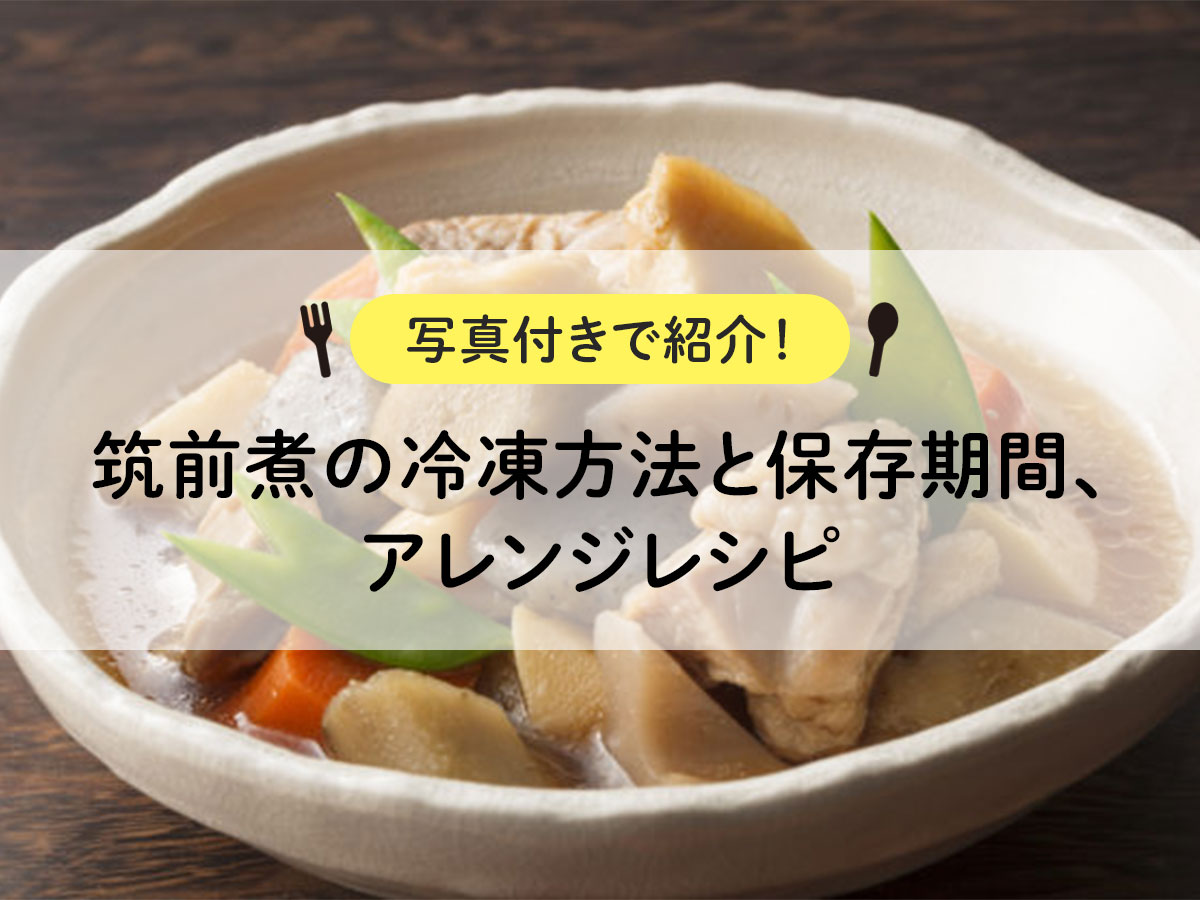
![[Thorough guide to preserving meat] Preservation methods, expiration dates, thawing methods, rapid freezing](https://shunkashutou.com/wp-content/uploads/2023/09/ec61889773cfed9c75aa97d9ca6c96dd-1.jpg)

![Introducing how to freeze corn and recipes [Explanation with photos! ]](https://shunkashutou.com/wp-content/uploads/2023/08/195a6cd4120bbae043606a677c71a7dc.jpg)
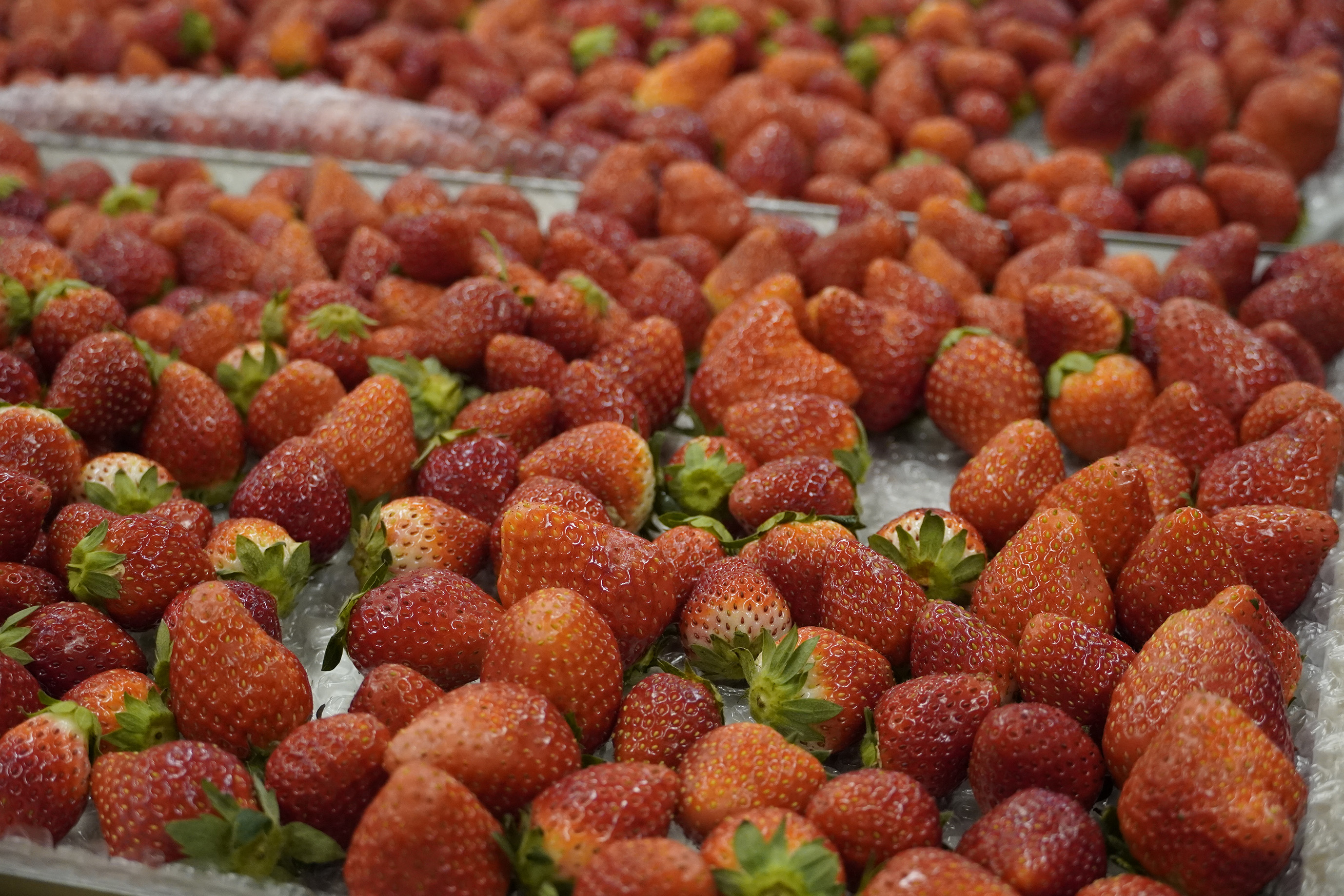
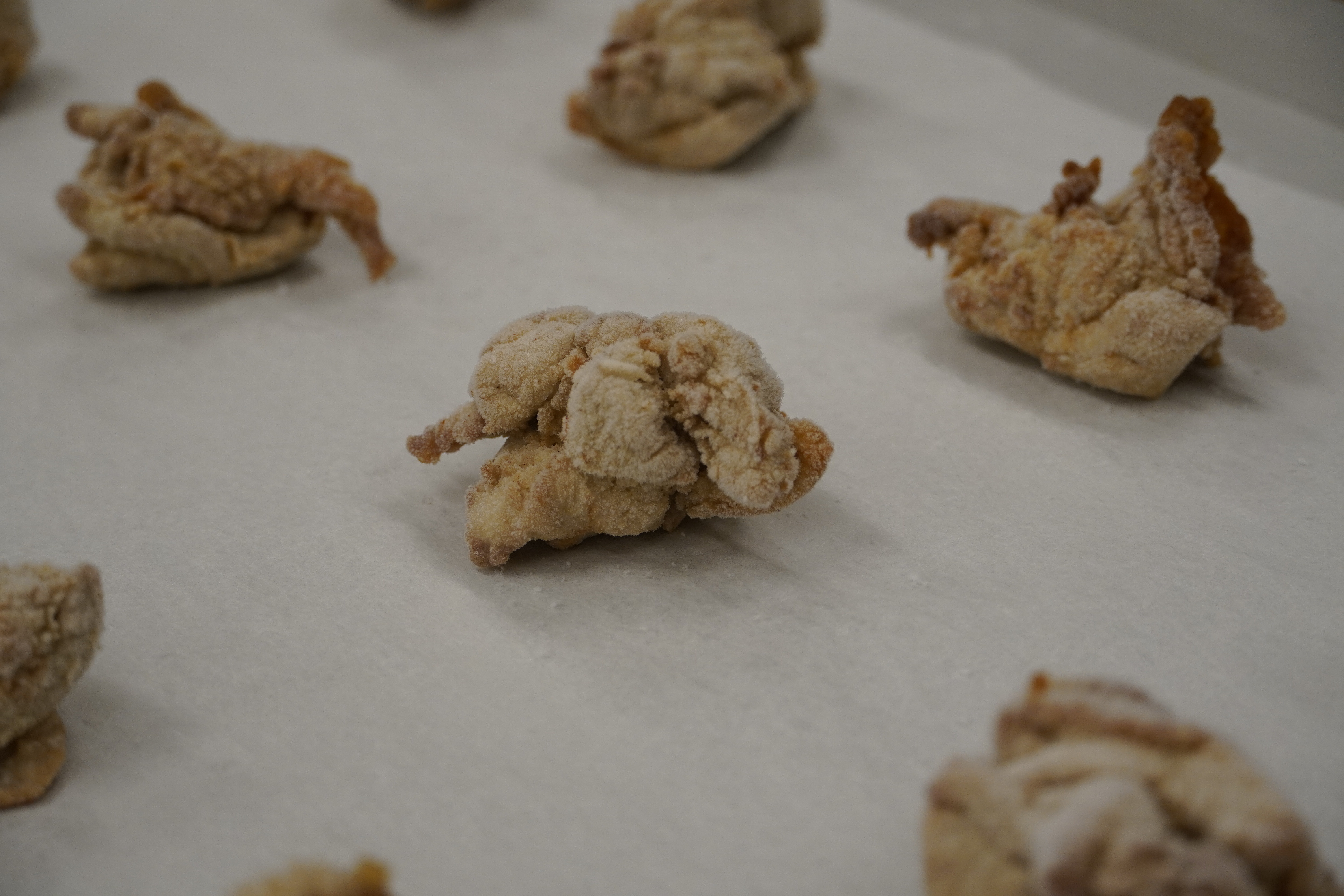
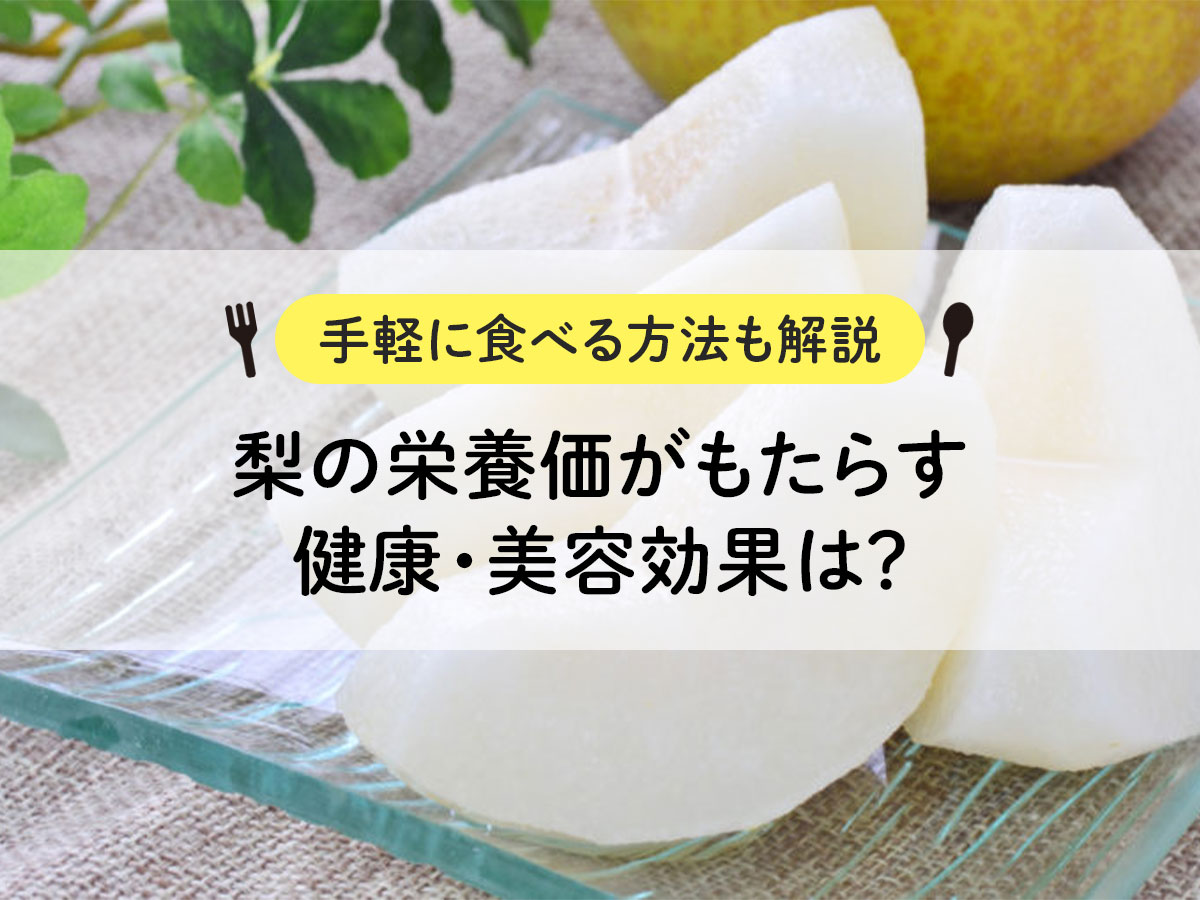
![[With photos] Lemon freezing and storage period, recipes for how to use frozen lemons](https://shunkashutou.com/wp-content/uploads/2023/09/21a01b705aff194717e200bf6dc6ce5b.jpg)
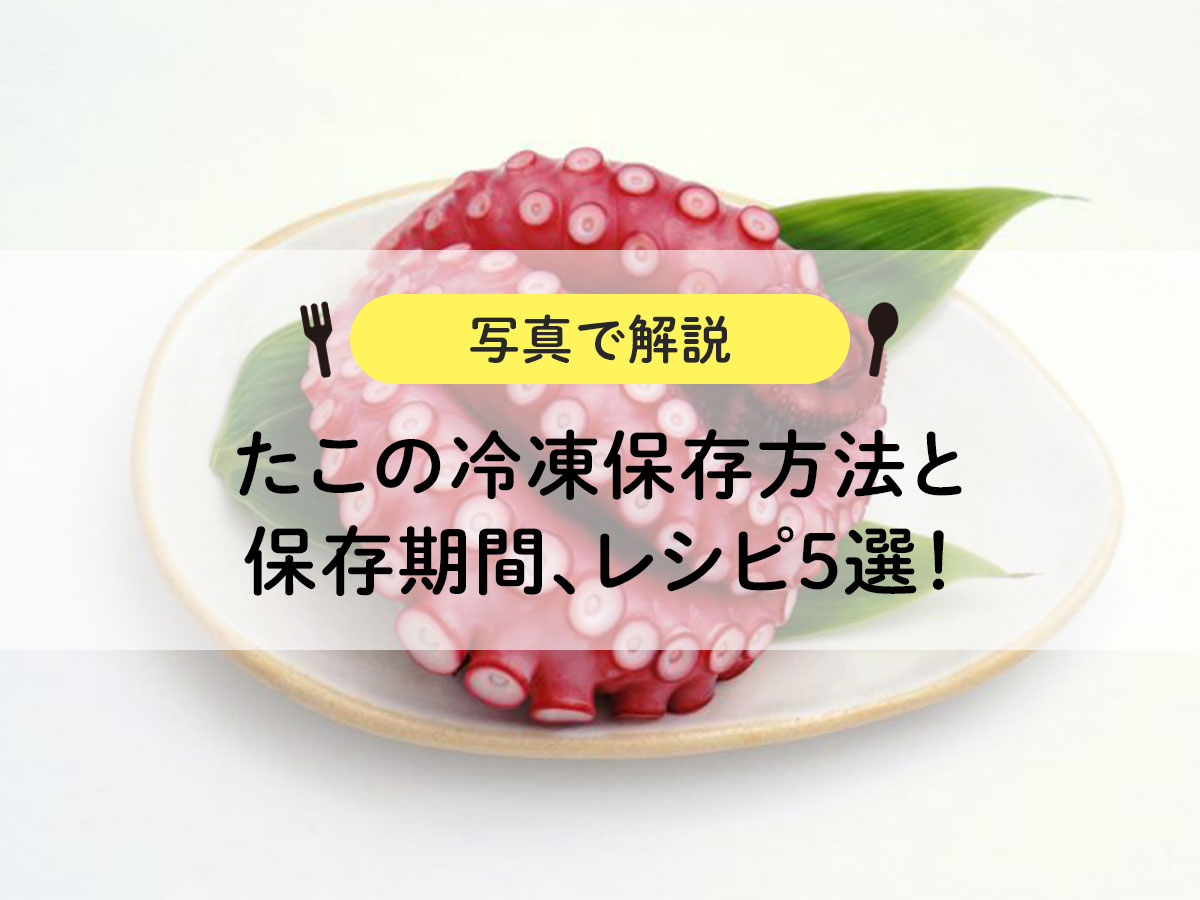
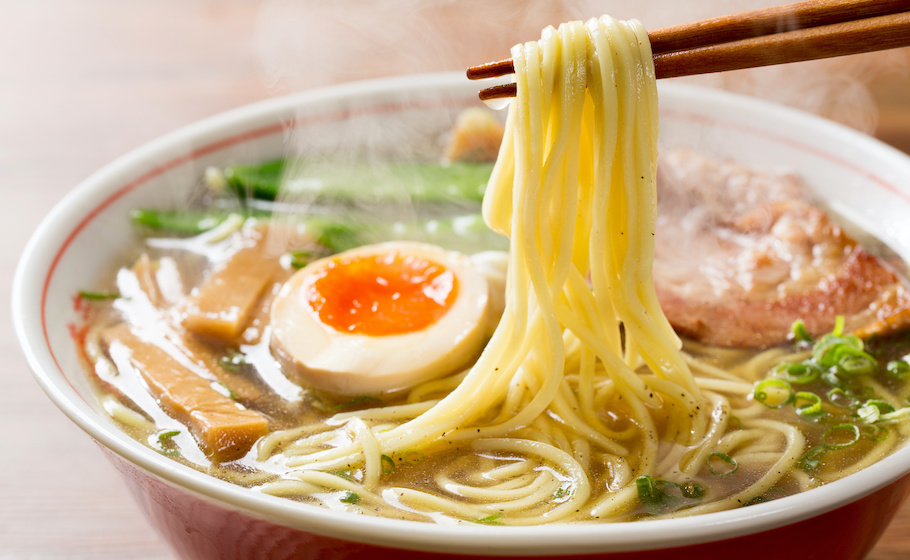
![Introducing how to freeze burdock and recipes [Explanation with photos! ]](https://shunkashutou.com/wp-content/uploads/2023/09/0812c28da547fe267723143edad2bfed.jpg)

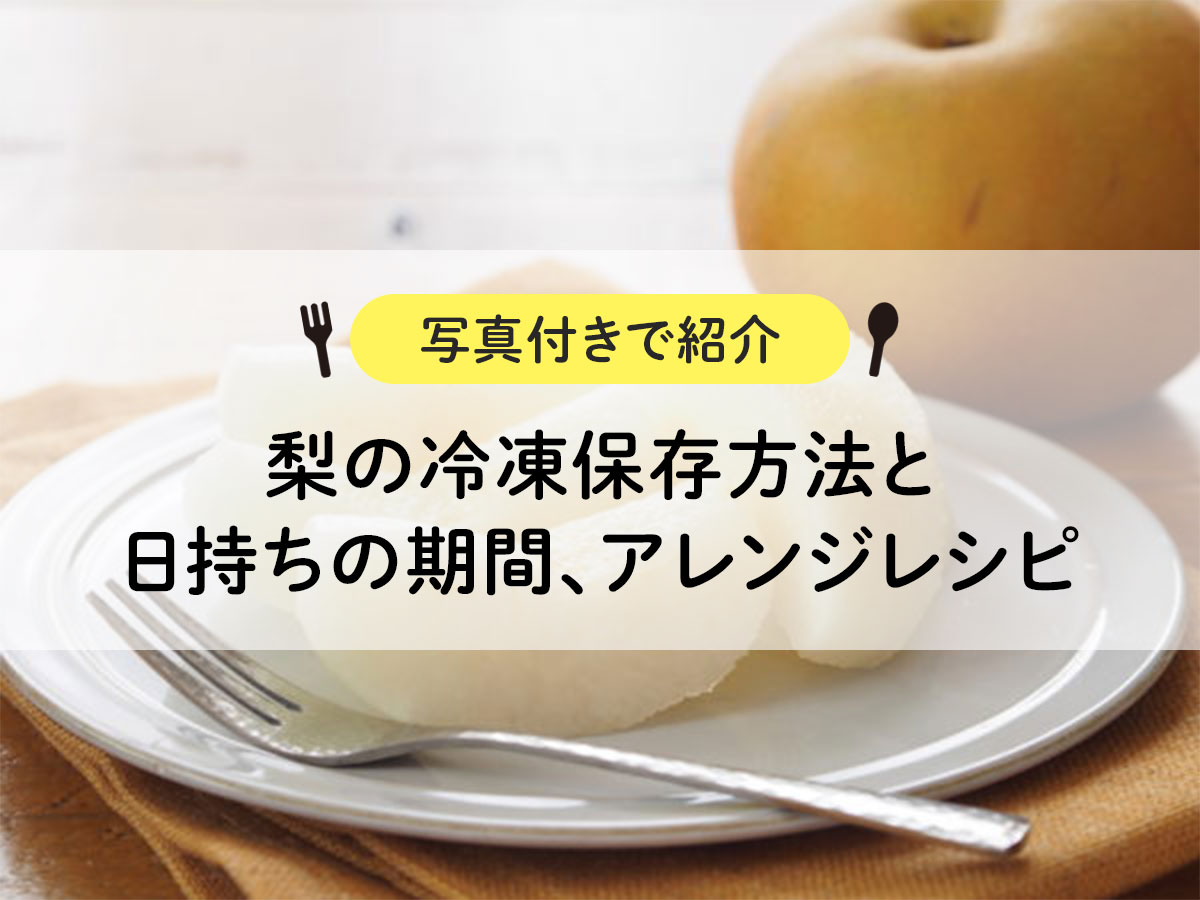
![[Easy thawing method] Low temperature thawing to lock in the deliciousness of meat](https://shunkashutou.com/wp-content/uploads/2024/08/899e71a518bbd73569bf085ff0accd61.webp)
![[How to freeze and store clams to improve nutrition] How to freeze and thaw clams and 5 recipes!](https://shunkashutou.com/wp-content/uploads/2023/07/ecfa61188368277d34c95d6667bf15fe.jpg)
![[Guide to handling frozen chicken for commercial use] How to thaw and how long it can be used after that](https://shunkashutou.com/wp-content/uploads/2018/04/36a79f65c113cc4318afbc48fa6229b7.webp)
![[Rapid defrosting or slow defrosting] Unsure of which method? Read the complete guide on how to defrost](https://shunkashutou.com/wp-content/uploads/2024/10/ec8d0eb82bcecb5525574a8f72183a97.webp)
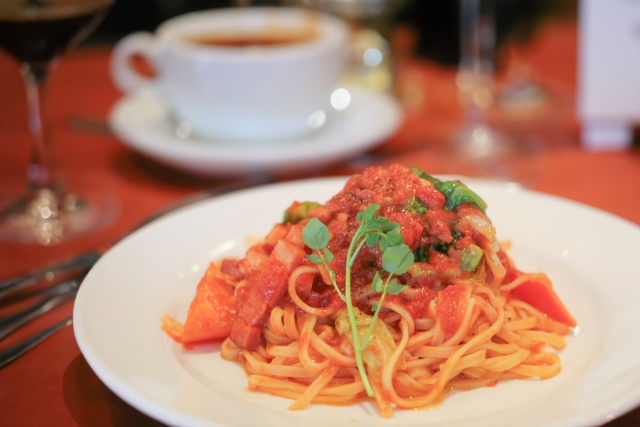
![[Introducing tricks and time-saving techniques! ] How to freeze ginger-yaki, carefully selected recipes](https://shunkashutou.com/wp-content/uploads/2023/10/ef145c31655c5774469e05b5e892207b.jpg)




